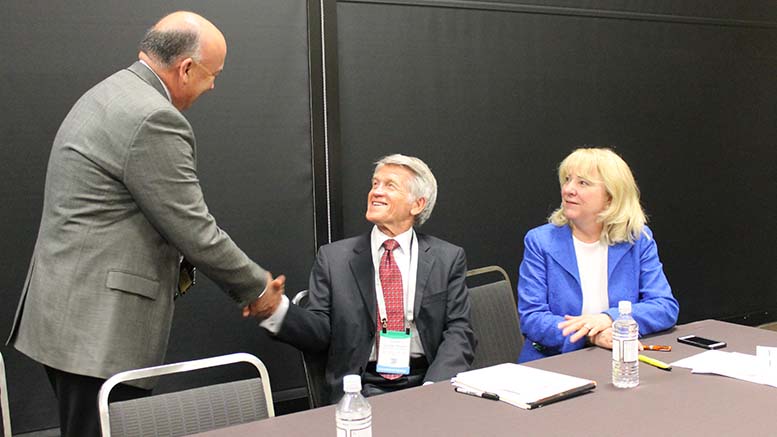NEW ORLEANS – Improving student success on a sustainable scale requires bold, holistic change.
Yet managing large-scale institutional change is one of the top challenges community college leaders face today, said Gunder Myran, senior consultant to the chancellor of the Wayne County Community College District (WCCCD) in Detroit. He spoke at a session on the entrepreneurial college at the American Association of Community Colleges (AACC) annual convention.
Myran cited the AACC Pathways Project as an example of a large-scale institutional change. It’s a multi-year effort in which 30 community colleges are designing and implementing structured curriculum pathways for every student.
Entrepreneurial colleges
According to Myran, an entrepreneurial college:
- “Manages and achieves bold, holistic, measurable large-scale change that increases student, business and community success at a sustainable level.”
- “Nurtures an institutional culture of innovation, collaboration, faculty and staff empowerment and recognition, and an openness to change that results in a commitment to a shared mission, values and goals.”
- Supports “purposeful and transformational initiatives that deconstruct and redesign policies, programs, services, structures, systems and processes that produce institutional-scale and sustainable changes that shape the strategic direction at the college as a whole.”
- Colleges implement large-scale change to reinvent the student experience; to respond to changing educational, community, economic, demographic, technological and cultural conditions; to increase the creative capacity of leaders and staff or “to nurture a culture attuned to student success and completion.”
Large-scale change calls for a college to explore its mission (“the most enduring statement of why we’re here”), Myran said, its values and culture, its vision (“what we want to be in five or 10 years”) and its strategic goals
Changing the culture, which encompasses, the institution’s mores and rituals, is the hardest type of change to make, Myran said.
“Leaders often fail because we don’t have the capacity to execute – to bring about a change agenda,” he said
Myran offered a couple examples of entrepreneurial community colleges, both in Florida, that are leaders in emerging national trends.
Valencia College is working on community innovation programs to facilitate large-scale organizational development of corporations, nonprofits, community organizations and other educational institutions.
Miami Dade College established student entrepreneurship programs aimed at equipping students with critical thinking, problem-solving skills, agility and imagination to prepare them to be business owners and ultimately have a positive impact on the local economy.
Design centers
Those colleges, along with WCCCD and Lone Star College in Texas, are among community colleges that have design centers that provide physical space for collaboration, innovation teams, and dedicated staff and resources that facilitate long-term, holistic change.
The Design Center at WCCCD was created by Chancellor Curtis Ivery to serve as the district’s innovation and entrepreneurial engine.
It supports leaders’ efforts to redesign and improve programs, services and processes; facilitates dialogue to help the college system anticipate the future and develop innovative responses; and encourages innovation and entrepreneurship through a cross-functional and team-based approach.
“Design thinking,“ Myran said, is an innovative process that involves creating new ideas and is used “to solve complex problems that are often unclear and have no definitive solution.”
After years of struggle, Detroit is making a huge comeback, and new employers are moving in, said Patrick McNally, vice chancellor at WCCCD for curriculum and distance learning. “Areas that we thought were fading out, like manufacturing, are coming back stronger than ever.”
The Design Center is enabling the college to adapt to those needs and determine how the college system can move forward as Detroit is evolving, McNally said.
“The Design Center allows us to see big the picture,” he said. Master plans are being developed for professional development, distance learning, curriculum, facilities and other areas. “Do we want the majority of classes online? What is the future of education in our region?” Those are kinds of questions the Design Center is dealing with.
Supporting strategic goals
For Lone Star Chancellor Steve Head, being an entrepreneurial college is critical in effecting change that supports its strategic goals.
Those goals are centered around student success, academic and workforce program quality, financial responsibility and accountability, a culture that encourages collaboration, and partnerships that promote student and community success.
“I’m okay with you making mistakes if you’re trying to do the right thing,” Head said. It’s important for leaders to understand that “when you have a culture that inspires creativity and innovation, it’s okay to make a mistake.”
“Everyone has ideas,” he said, “but trying to find someone to take the idea and do something with it, that’s different.”
Lone Star, with more than 95,000 students and 7,000 employees, is a big business that has to manage its resources. “That does’t mean everything has to work right initially,” Head said, but decisions need to be made with an eye on the bottom line.
Lone Star’s corporate college provides customized technical training for industry partners – with a built-in profit margin – that brings in revenue to support other college programs.
Lone Star’s campus in Jakarta, Indonesia, has a 25 percent return on investment that generates $1.7 million.
Only 21 percent of Lone Star’s budget comes from the state, and that’s been shrinking every year. The more a college is able to generate revenue, the more positive things it can do to support students, Head said.
“Every project I ever worked on, somebody has said, ‘No we don’t need to be doing that,’” he noted. “We point out the advantages; we focus on what we’re going to get out of it.”

